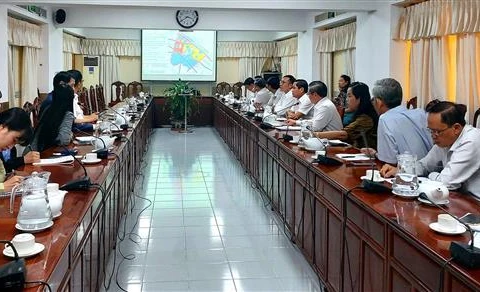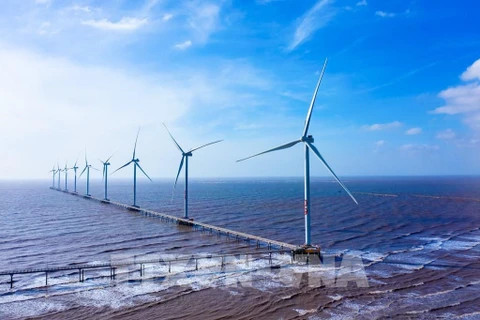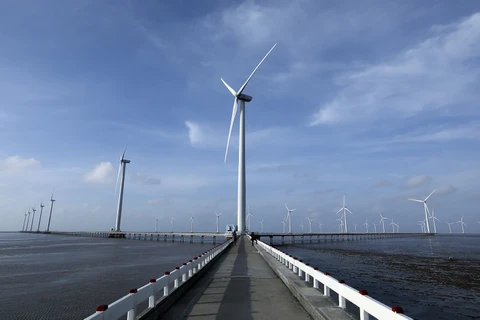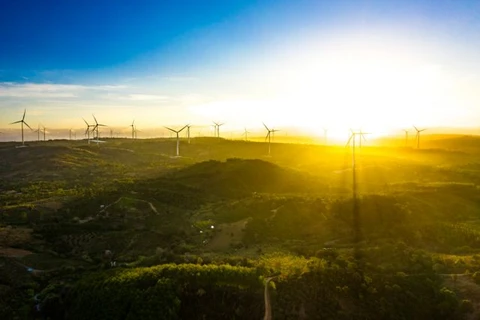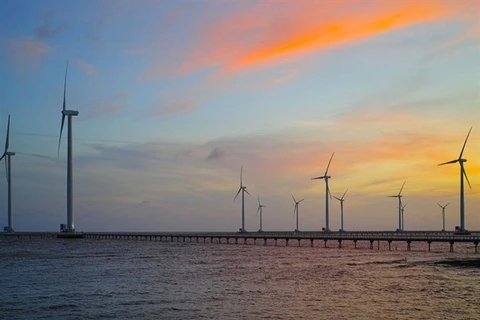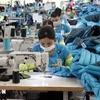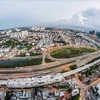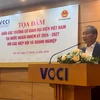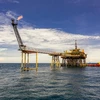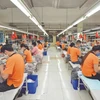Quang Ninh (VNA) – Mong Cai city, the northern province of Quang Ninh, is planning to develop renewable energy on Vinh Thuc and Vinh Trung islands in the near future.
Chairman of the municipal People’s Committee Ho Quang Huy said Mong Cai is working to carry out the announced strategies and plans to gradually modernise infrastructure, especially in coastal areas.
Among those strategies and plans, the city will boost the development of renewable energy to switch from traditional energy sources such as coal, oil, and natural gas to green and safer ones like wind, solar, hydrological, and biological energy in line with the common orientations set up by central and provincial agencies, he noted.
According to an adjusted general planning for the Mong Cai Border Gate Economic Zone approved by the Prime Minister, the zone has a total area of about 121,197 hectares, including 66,197 hectares on land and 55,000 hectares on water that includes such islands as Vinh Trung and Vinh Thuc of Mong Cai city and Cai Chien of Hai Ha district.
Mong Cai city and the Mong Cai Border Gate Economic Zone boast a long coastline, favourable weather conditions for developing renewable energy like solar and wind power, as well as resilience to storms, making them ideal places for long-term and stable power generation.
Huy said municipal authorities are moving to adjust the planning of Division D1 in the vicinity of Vinh Trung and Vinh Thuc islands to suit the clean and renewable energy development directions issued by the Quang Ninh administration and central agencies.
After the planning is finalised, Mong Cai will invite capable and experienced investors to develop a wind power system, the official went on, adding that the development of clean and renewable energy will help create an impulse for the local economy to grow, natural values to be upheld, the city’s standing in the common development trend to be elevated, and related policies and resolutions of central and provincial administrations to be implemented.
He added that his city will maximise maritime potential while enhancing the monitoring and protection of the marine environment to help sustainably develop sea-based economic activities.
As a coastal city with rich potential for economic development, Mong Cai holds a strategic position in Quang Ninh province and Vietnam as a whole. Over the past years, it has always attached importance to preserving and bringing into play natural values and promoting renewable energy, Huy said.
In March this year, the Quang Ninh People’s Committee issued a document on studying the potential of offshore and land-based wind power in the province. It assigned the provincial Department of Industry and Trade to coordinate with some units to survey areas for wind power development, including Vinh Trung and Vinh Thuc islands.
Meanwhile, in a draft planning of Quang Ninh by 2030 submitted to the Prime Minister, the province identified several focuses, including developing an environmentally friendly energy industry, maintaining its role as an energy centre of Vietnam and a wind and LNG-fired power centre in the northern region, gradually switching to clean and renewable energy, and developing land-based, inshore, and offshore wind power with total initial capacity of about 2,500 MW.
On February 11, 2020, the Politburo issued Resolution No 55-NQ/TW on orientations for the national energy development strategy by 2030, with a vision to 2045, which gives priority to the capitalisation of renewable, new, and clean energy sources. On October 2 the same year, the Government released Resolution No 140/NQ-CP on an action plan for implementing the Politburo’s resolution./.
Chairman of the municipal People’s Committee Ho Quang Huy said Mong Cai is working to carry out the announced strategies and plans to gradually modernise infrastructure, especially in coastal areas.
Among those strategies and plans, the city will boost the development of renewable energy to switch from traditional energy sources such as coal, oil, and natural gas to green and safer ones like wind, solar, hydrological, and biological energy in line with the common orientations set up by central and provincial agencies, he noted.
According to an adjusted general planning for the Mong Cai Border Gate Economic Zone approved by the Prime Minister, the zone has a total area of about 121,197 hectares, including 66,197 hectares on land and 55,000 hectares on water that includes such islands as Vinh Trung and Vinh Thuc of Mong Cai city and Cai Chien of Hai Ha district.
Mong Cai city and the Mong Cai Border Gate Economic Zone boast a long coastline, favourable weather conditions for developing renewable energy like solar and wind power, as well as resilience to storms, making them ideal places for long-term and stable power generation.
Huy said municipal authorities are moving to adjust the planning of Division D1 in the vicinity of Vinh Trung and Vinh Thuc islands to suit the clean and renewable energy development directions issued by the Quang Ninh administration and central agencies.
After the planning is finalised, Mong Cai will invite capable and experienced investors to develop a wind power system, the official went on, adding that the development of clean and renewable energy will help create an impulse for the local economy to grow, natural values to be upheld, the city’s standing in the common development trend to be elevated, and related policies and resolutions of central and provincial administrations to be implemented.
He added that his city will maximise maritime potential while enhancing the monitoring and protection of the marine environment to help sustainably develop sea-based economic activities.
As a coastal city with rich potential for economic development, Mong Cai holds a strategic position in Quang Ninh province and Vietnam as a whole. Over the past years, it has always attached importance to preserving and bringing into play natural values and promoting renewable energy, Huy said.
In March this year, the Quang Ninh People’s Committee issued a document on studying the potential of offshore and land-based wind power in the province. It assigned the provincial Department of Industry and Trade to coordinate with some units to survey areas for wind power development, including Vinh Trung and Vinh Thuc islands.
Meanwhile, in a draft planning of Quang Ninh by 2030 submitted to the Prime Minister, the province identified several focuses, including developing an environmentally friendly energy industry, maintaining its role as an energy centre of Vietnam and a wind and LNG-fired power centre in the northern region, gradually switching to clean and renewable energy, and developing land-based, inshore, and offshore wind power with total initial capacity of about 2,500 MW.
On February 11, 2020, the Politburo issued Resolution No 55-NQ/TW on orientations for the national energy development strategy by 2030, with a vision to 2045, which gives priority to the capitalisation of renewable, new, and clean energy sources. On October 2 the same year, the Government released Resolution No 140/NQ-CP on an action plan for implementing the Politburo’s resolution./.
VNA

